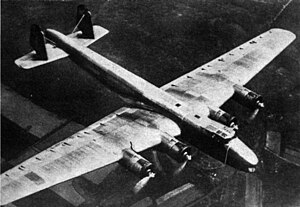Dornier Do 19
| Do 19 | |
|---|---|
 |
|
| Dornier Do 19 | |
| Role | Heavy bomber |
| Manufacturer | Dornier-Werke GmbH |
| First flight | 28 October 1936 |
| Status | cancelled |
| Primary user | Luftwaffe |
| Number built | 3 |
The Dornier Do 19 was a German four-engine heavy bomber that first flew on October 28, 1936. Only one prototype flew, and it was converted to a transport in 1938. The other two were scrapped.
The Luftwaffe had a shortcoming in the lack of an efficient heavy bomber fleet. Generalleutnant Walther Wever, the Luftwaffe's first Chief of Staff, was the most persistent advocate of a German long-range strategic bomber fleet. It was built for the Luftwaffe's Ural bomber program under General Wever, competing against the Junkers Ju 89. The RLM Technisches Amt issued a specification for a four-engine heavy bomber. But after Wever's death in an airplane crash in June 1936, Wever's successor, Albert Kesselring, canceled Germany's long-range bomber projects to concentrate on tactical bombers.
Both Dornier and Junkers were competitors for the contract, and each received an order for three prototypes in late 1935. The Dornier design was given the project number of Do 19, while the Junkers prototype became the Ju 89.
The Dornier Do 19 was a mid-wing cantilever design, and was mostly metal in construction. It had a rectangular-section fuselage and a tail unit, quite similar to the one fitted to the contemporary British Armstrong Whitworth Whitley medium bomber, with braced twin fins and rudders, mounted on the upper surface of the tailplane, itself set low on the rear fuselage as the Whitley's was. It also had retractable landing gear, including the tail wheel. The power plant, according to some sources, was supposed to be four Bramo 322H-2 radial engines that were mounted in nacelles at the leading edges of the wings.
...
Wikipedia
